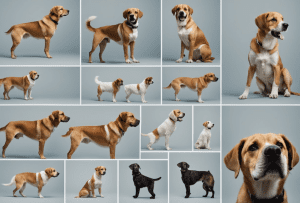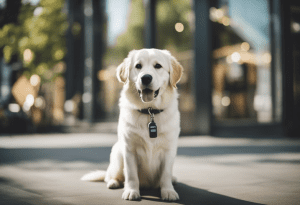Understanding your dog’s body language is crucial to building a strong relationship with your furry friend. Dogs use body language to communicate their emotions, intentions, and needs. As a responsible pet owner, it’s essential to learn how to read and interpret your dog’s body language to ensure their health, happiness, and safety.

Dogs use a variety of body language cues, including facial expressions, body posture, and tail position, to communicate with their owners and other dogs. For example, when a dog’s tail is in motion with a lively wag, it often conveys feelings of happiness or excitement, whereas a tail tucked between their legs tends to indicate emotions like fear or anxiety. By understanding these cues, you can better understand your dog’s emotional state and respond appropriately.
Learning how to read your dog’s body language can also help prevent potential conflicts with other dogs. By recognizing when your dog is feeling uncomfortable or threatened, you can remove them from the situation before it escalates. Additionally, understanding your dog’s body language can help you identify when they are in pain or discomfort, allowing you to seek veterinary care promptly.
Understanding the Basics of Canine Communication
Here are some basics of canine communication that you should know:
Facial Expressions
A dog’s face can convey a lot of information about their mood and intentions. For example, if your dog is relaxed, their mouth will be slightly open, and their tongue may be hanging out. On the other hand, if your dog is feeling aggressive, their mouth will be tightly closed, and their lips may be curled back to reveal their teeth.
Body Posture
Dogs use their body posture to communicate their intentions and emotions. For example, if your dog is feeling confident and dominant, they will stand tall with their head held high. On the other hand, if your dog is feeling scared or submissive, they will lower their body and tuck their tail between their legs.
Vocalizations
Dogs use a variety of vocalizations to communicate, including barks, growls, whines, and howls. Each vocalization conveys a different message. For example, a low may signify aggression or a sense of danger, while a high-pitched whine might reveal feelings of unease or fear in your four-legged friend.
Smells
Dogs use their sense of smell to communicate with each other. They use pheromones to mark their territory and communicate their presence to other dogs. Paying attention to your dog’s sense of smell can help you understand their mood and intentions. For example, if your dog is sniffing around a particular area, they may be trying to communicate something to you.
Decoding Your Dog’s Facial Expressions

Your dog’s face can reveal a lot about how they’re feeling. Here’s how to decode some of the most common facial expressions:
Eyes
Your dog’s eyes can communicate a lot about their emotional state. For example, if your dog is feeling relaxed and content, their eyes will be soft and squinty. On the other hand, if your dog is feeling anxious or scared, their eyes will be wide open and their pupils may be dilated.
Ears
Your dog’s ears are another important part of their facial expression. If your canine companion’s ears are standing upright and pointed forward, it signifies their keen interest and alertness to their environment.. If their ears are flattened against their head, it means they’re feeling scared or submissive.
Mouth
Your dog’s mouth can also reveal a lot about how they’re feeling. If your dog’s mouth is relaxed and slightly open, it means they’re feeling calm and content. If their mouth is tightly closed and their lips are pulled back, it means they’re feeling anxious or aggressive.
It’s important to remember that every dog is different, and what one dog’s facial expression means may be different from another dog’s. However, by paying attention to your dog’s eyes, ears, and mouth, you can get a better sense of how they’re feeling and respond accordingly.
Interpreting Your Dog’s Body Postures

Dogs communicate their emotions and intentions through their body postures, and it’s up to you to interpret them correctly. Here are some common body postures and what they mean.
Tail Wagging
Contrary to popular belief, not all tail wagging is a sign of happiness. A relaxed and loose tail wag usually indicates a happy and friendly dog. However, a stiff and rapid tail wag can indicate aggression or fear. A tail tucked between the legs indicates fear or submission, while a raised tail indicates dominance or excitement.
Body Positioning
A dog’s body positioning can also tell you a lot about their mood. A relaxed and open stance with a slightly wagging tail indicates a friendly and approachable dog. A tense and stiff body with a closed mouth and raised fur indicates aggression or fear. A dog that is crouched with their weight shifted forward is preparing to attack or defend themselves.
When approaching a dog, it’s important to pay attention to their body language and approach slowly and calmly. If a dog is showing signs of aggression or fear, it’s best to give them space and avoid approaching them. Remember, every dog is different, and it’s important to get to know your dog’s unique body language to understand their emotions and intentions.
Recognizing Vocalizations
Dogs communicate not only through body language but also through vocalizations. Understanding what your dog is trying to tell you through their barking, growling, and whining can help you better respond to their needs and emotions.
Barking
Barking is one of the most common vocalizations dogs make. It can mean different things depending on the context and tone. For example, a short, sharp bark may indicate excitement or alertness, while a long, drawn-out bark may signal boredom or frustration.
It’s important to pay attention to the accompanying body language when interpreting your dog’s barking. If your dog is barking while wagging their tail and jumping up and down, they may be expressing happiness and excitement. If they are barking while cowering and backing away, they may be feeling scared or threatened.
Growling
Growling is often seen as a sign of aggression, but it can also be a warning signal. Dogs may growl when they are feeling anxious, scared, or uncomfortable. It’s important to take your dog’s growling seriously and try to identify the trigger.
If your dog is growling while showing their teeth and stiffening their body, they may be feeling aggressive. In this case, it’s important to remove them from the situation and seek the help of a professional trainer or behaviorist. However, if your dog is growling while crouching down and tucking their tail between their legs, they may be feeling scared or submissive.
Whining
Whining is another common vocalization dogs make. It can indicate a variety of emotions, such as anxiety, excitement, or pain. If your dog is whining excessively, it’s important to try to identify the cause.
If your dog is whining while pacing back and forth and panting, they may be feeling anxious or stressed. If they are whining while holding their paw up or limping, they may be in pain or discomfort. In either case, it’s important to seek the help of a veterinarian or professional trainer to address the underlying issue.
Understanding Your Dog’s Behavior in Different Situations

Here are some common situations where understanding your dog’s body language can be helpful:
During Play
Playtime is an important part of your dog’s life, and it’s important to understand their body language during play. A dog that is happy and playful will have a relaxed body posture, wagging tail, and may even play bow. On the other hand, a dog that is feeling overwhelmed or scared may cower, tuck their tail, and avoid eye contact. If your dog is growling or showing their teeth during play, it’s important to intervene and redirect their behavior.
During Meal Times
Dogs can be protective of their food and may display aggressive behavior if they feel threatened during meal times. It’s important to teach your dog to be comfortable with people being around their food, but it’s also important to understand their body language during meal times. If your dog is growling or showing their teeth while eating, it’s best to give them space and avoid interacting with them until they are finished.
When Meeting Strangers
Meeting new people can be stressful for dogs, and it’s important to understand their body language during these interactions. A dog that is feeling threatened or scared may cower, tuck their tail, and avoid eye contact. On the other hand, a dog that is feeling confident may have a relaxed body posture and wagging tail. It’s important to introduce your dog to new people slowly and in a controlled environment to avoid overwhelming them.
Understanding your dog’s body language can help you better understand their behavior in different situations. By paying attention to their body posture, tail position, and facial expressions, you can better communicate with your dog and build a stronger bond.
Ever since she was a child, Simi has had a profound love for dogs, a passion that has grown stronger with each passing year. She's had the joy of sharing her life with a diverse array of canine companions, each with their own unique personality and story. Her days are filled with walks, playful barks, and endless affection, making her an unmistakable dog enthusiast whose heart is as warm and welcoming as her furry friends

